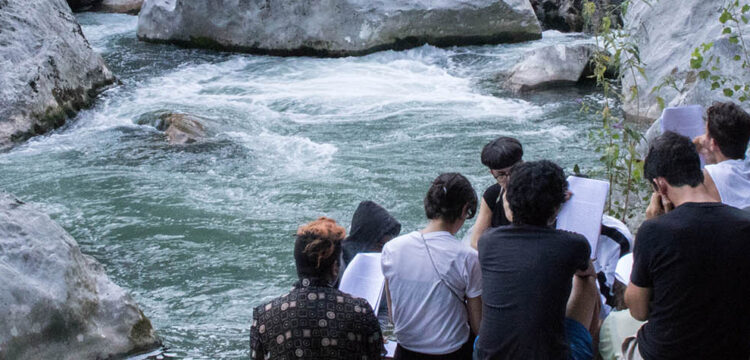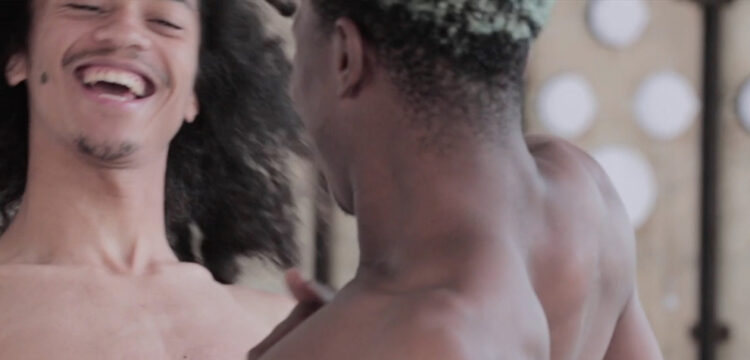A History We Have Lost
On affective, somatic, visual knowledges censored or suppressed by Western sex-colonial modernity
KAS is a group exhibition with a performative nature that constitutes the third episode of Trilogia anti-moderna, a cycle of exhibitions curated by Simone Frangi and Barbara Boninsegna, that Centrale Fies has been dedicating for some years now to the relationship between objects and their activations, re-evaluating forms of affective, somatic, visual knowledges censored or suppressed by Western sex-colonial modernity.
After the group exhibition Storia Notturna (2020) dedicated to the exploration of practices of performative witchcraft and the two-person show by Josefa Ntjam and Joar Nango (2021) committed to the deconstruction of the Eurocentric concept of genealogy and of orientalizing and depoliticized versions of the idea of indigeneity, KAS reflects together with a group of international artists on the function of mythological topoi and of the collective fabrication of images of “primordial urbanity” in the founding processes of “imagined communities”.
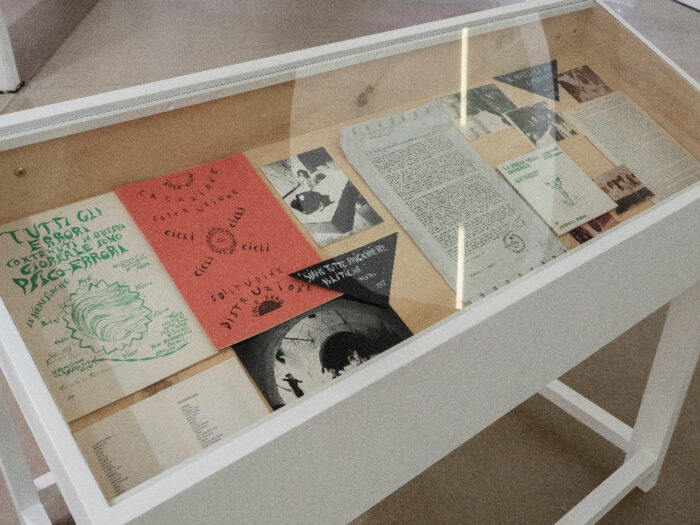
The title is based on Kas, a pre-modern city that is said to have existed on the site of Fies before the great landslide that created the Marocche biotope in prehistoric times. The discovery of a brick—whose “truthfulness” and “authenticity” are still debated by historians from the region—is evidence of this, and it is kept alive by popular fables and the pictorial production of the local pharmacist Alfeno Liboni. Kas becomes the starting point for artists to articulate a series of socio-political questions underlying certain mythological imaginaries that, despite being considered harmless, are in reality innervated by forms of critical struggle against oppressive architectures: speculative archaeology and speculative orography as a source of legitimation of nationalisms or their strategical re-appropriation in an anti-nationalist function; symbolic and material violence of founding processes as well as their transmission and reproduction through material and visual archives or through hegemonic notions of heritage and cultural inheritance; the artificiality of the time of history and its tripartition into past, present and future; the affirmativeness of speculative notions such as “futurity” and “catastrophe”; the reform of the artificial concept of “objectivity” and the possibilities opened by its erosion.

The exhibition is opened by To let them know what we think about them by Belinda Kazeem-Kamiński. The installation consists of three Asafo flags that Belinda Kazeem-Kamiński created together with renowned Ghana-based flag maker Baba Issaka, who takes up the tradition of creating commemorative and ceremonial textile flags. Asafos—translating to “the War People”, from sa, “war”, and fo, “people”—were traditional warrior organizations concerned with the defense and welfare of their communities. Each Asafo had its own name, number, regalia, shrine, and flag and its members had precisely defined roles. Asafo flags were the symbols of the communities who held them, but also a visual metaphor of what bound their members together, be it a historic event, a foundational scene, or an aphorism. The flags in the exhibition were created in that function: to commemorate the West-African performers brought to Vienna, going beyond the representations found in the colonial archival. Belinda Kazeem-Kamiński has chosen three scenes to be translated into fabric: a portrait of a girl taken from what is thought of as a photograph taken by Peter Altenberg, a hand holding a Sankofa bird, and a hand holding a (golden) peanut. The peanut, a plant whose history intersects with the history of enslavement, also refers here to the Austrian word “Aschanti”, used to designate peanuts and originally being the German translation for “Asante”, meaning the people of the Asante Kingdom in the region modern-day Ghana. The Sankofa bird is a foundational image in the African diaspora: as it walks into the future, sometimes carrying an egg in its beak, it looks backward in order to not forget what has happened, to always keep in mind what has come before and to build a future.

Vanja Smiljanić’s Labyrinth-rider (in a search of Atlantis) is a tool allowing the artist to hypnotically explore the famous ur-continent. “There is a labyrinth. Its official name is ‘Past Life Therapy Machine’. It is a tool that has been designed to be maneuvered. Both formally and physically, it is a three-dimensional inception labyrinth with a function to breach the linearity of time through a spirographic modus operandi. The way the labyrinth is constructed enables the labyrinth-rider to engage with it on three different levels: macro, meso, and micro, at the same time. We load the labyrinth and qualify its main construction blocks with three characters. FIRST, we enter the labyrinth. THEN, we reach the center. THEN in a mirrored movement, we exit the labyrinth. We enjoy the ride. ‘The tool’ from the Labyrinth riders (Disremembering Atlantis). In the 0th dimension it is a point. In the 1st dimension a line. In the 2nd dimension a shape. In the 3rd dimension a tool. We linger here for a moment. In the 3rd dimension in 360 BCE Plato writes the dialogues Timaeus and Critias where he introduces for the first time the concept of Atlantis. It is an island beyond the Pillars of Hercules populated by fierce warriors. He creates an initial impulse that ripples beyond his control and drastically changes the course of human imagination. Zooming out. In the 4th dimension time enters the equation. In the 5th and 6th dimension, the notion of possible worlds arises. In the 7th we gain access to the possible worlds that start with different initial conditions. We linger here for the time being. Plato, a greek philosopher and Donovan, the Scottish singer-songwriter become twin souls. This is where the story begins.”
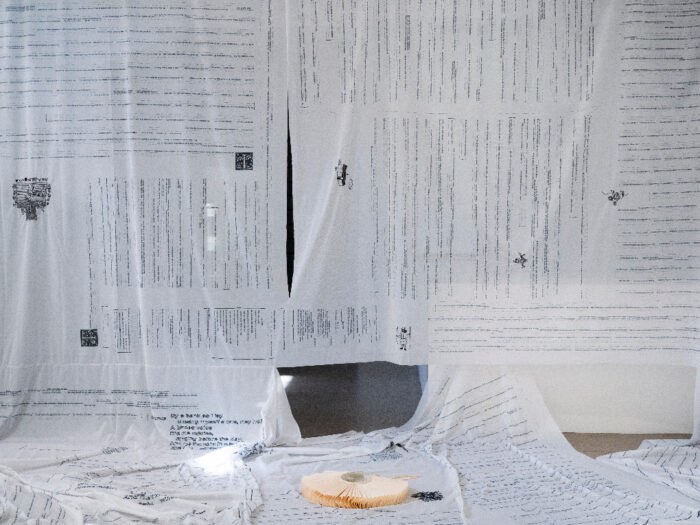
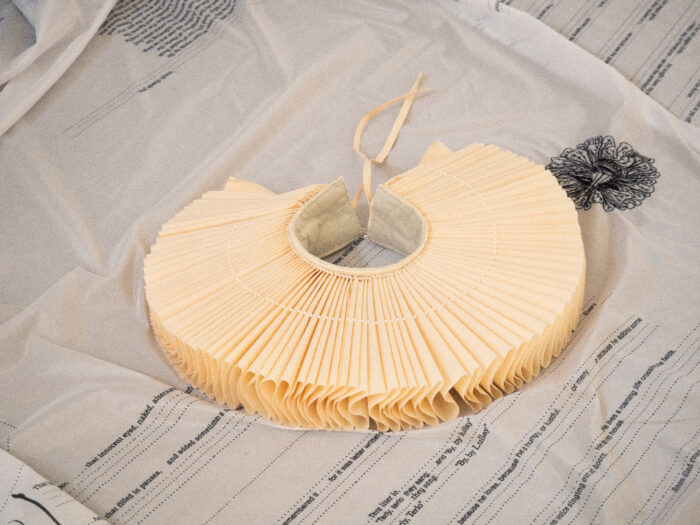
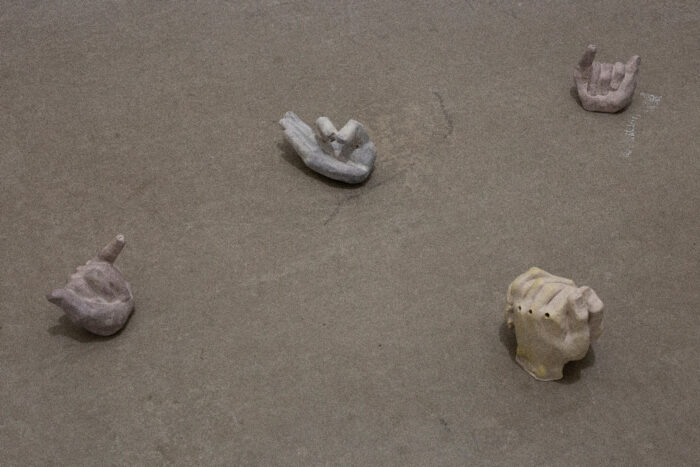
Simon Asencio’s Reading at Random or Turning The Page (Or Singing Out of Doors) is a reading score for four voices, based on an unfinished essay by Virginia Woolf titled Anon. This prose poem tells the thousand year story of one protagonist Anon, the anonymous singer, who spoke to an audience just as anonymous. The tale of Anon invokes figures, characters and myths from another time—a time prior to the formation of the author—to reassess the importance of the common womxn and men in the history of literature and poetic forms. Virginia Woolf’s attempted essay is an opportunity to imagine text as a technology that could dissolve the authority of the individual and suggest collective agency in writing and reading. Composed of edited drafts and transcripts of the original manuscripts of Anon the score was annotated with embroideries and accompanied by contemporary writers (Samuel R. Delany, Alina Popa, Octavia Butler, Ursual K. Le Guin, Tim Ingold) in an attempt to pursue its project and study. Asencio presents also Robin Hood, Hugh Latimer, The Elizabethans, Lancelot et al., series of hand made clothes aiming to activate the reading score of Reading at Random or Turning The Page (Or Singing Out of Doors) through a communal reading. A situation oscillating between a reading group, a play without actors and a live act role play. This ever growing corpus of handmade and readymade garments invokes the community of supporting characters narrated in Virginia Woolf’s text Anon and suggests the possibility of their provisory embodiment. Completing Asencio’s installation we find The Vain Dreamer (1765)], Flute [Villion’s Good Night (1887)], Flute [Song of the Beggar (1620)] (2021)a series of inked faience wind instruments paying homage to anonymous cant songs compiled by John S. Farmer. Farmer’s anthology borrows his title from the Musa Pedestris: the wandering muse whose poetry is that of prose and of the common language, suggesting that slang, cant and vernacular phraseologies are the roots of the poetry form. These instruments are thought of as aids for those who have lost the ability to sing, for those who can no longer imitate the bird voice. Hugh Latimer was a priest. He joined a group of reformers that met regularly at the White Horse Tavern to discuss Martin Luther’s new doctrines. His fervent reformist preaching in the English tongue led him to the stake. “When Latimer said the Lord’s prayer in English he was putting English into high places. He was rescuing it from the back door. He was teaching the nobles and the peasants to respect their mother tongue [and was providing] the old minstrels a new lease of life.”
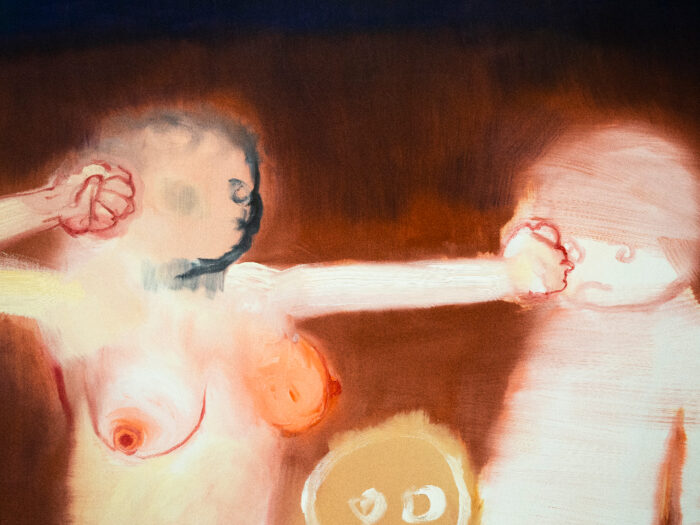
At the center of the exhibition we find Miriam Cahn’s O.T. (2012) an oil on panel from the De Iorio Collection. Cahn’s work is based on the image of the body, and more precisely on the conditions under which this image appears: the way it emerges and disappears. In her pictorial worlds, the Swiss artist pushes for the abolition of social norms and counters the traditional representation of women and specific gender roles. The diaphanous and the spectral characterizes the essence of her figurative approach, which includes painting, drawing and photography.
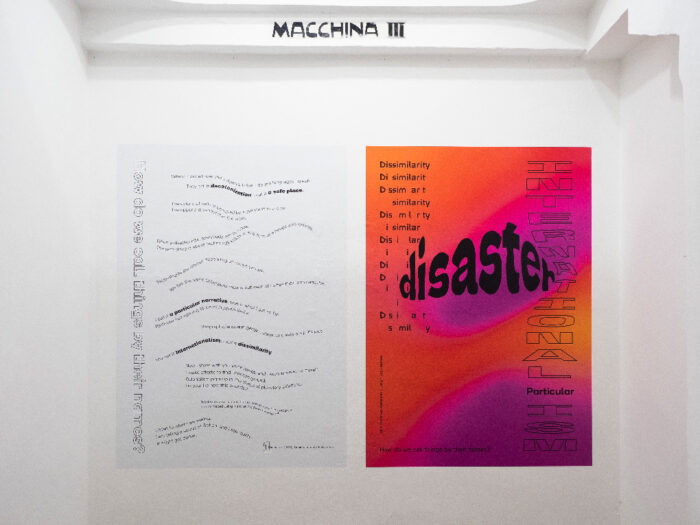
Mohamed Abdelkarim’s written/spoken lyric How do we call things by their names? contemplates, problematizes, and redefines “Modernity,” its shape of language and discourse bears and expands on the social and political implications for the future disaster as a post-planetary supposition. It employs and reflects on performative acts such as narrating, singing, surveying, making, romancing and recently speculating. Abdelkarim’s recent umbrella project focuses on the agency of landscape as a witness to “a history we have lost and a future we have not yet attended.”
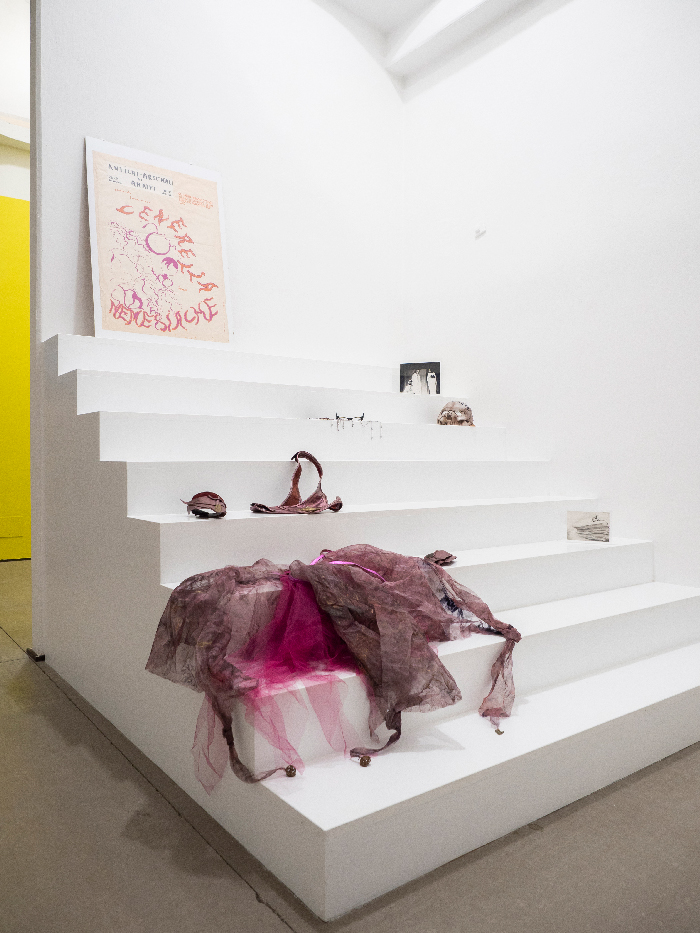
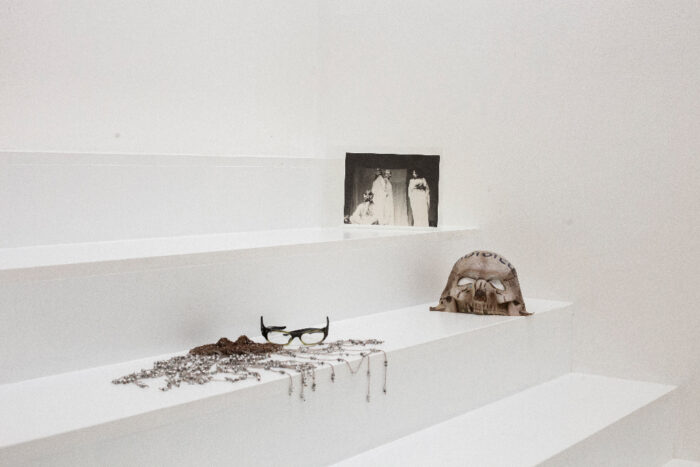
Giulia Damiani is a writer, researcher, curator and dramaturg based in London and Amsterdam. Since 2013 she has researched the artistic and political activity of the Naples-based feminist group Le Nemesiache, collaborating with the group and various artists. Founded by Lina Mangiacapre in 1969, the activity of Le Nemesiache was based on the “psycho-fable”, a consciousness raising method that led them to experiment with the body, myth and in relation to geomorphic elements to regain a sense of agency and belonging to reality. Giulia Damiani’s work with Le Nemesiache continues an in-depth investment in a feminist landscape, both grounded and cosmic. The intense research relationship and performative approach to the group’s history keeps alive the promise of moments of eruptive intimacy and dance, a promise encapsulated in the artistic materials of Le Nemesiache. The ritualized actions of the group in and around Naples, crossing the boundaries of the body into the landscape, researched and re-imagined bodies as well as urban spaces and natural elements. Le Nemesiache sought clues to finally shake up the extractive and patriarchal apparatus, culturally and politically. The work shows how they found volcanic traces, temples, rocks and abandoned industries, bringing them together in a continuous dance and generating an explosive and porous understanding of bodies and places. This speculative project through exhibition and voice speaks of the psycho-fable as a slow process of learning with the group, intimate and transformative; as well as the attempt to make it circulate and vibrate beyond. In the space there are fragments and materials produced by Le Nemesiache in the 70s and 80s such as original documents, manifestos, photographs, videos, costumes and textiles that speak of their political and creative actions. The objects in the exhibition have been kindly provided by the Mangiacapra Archive.
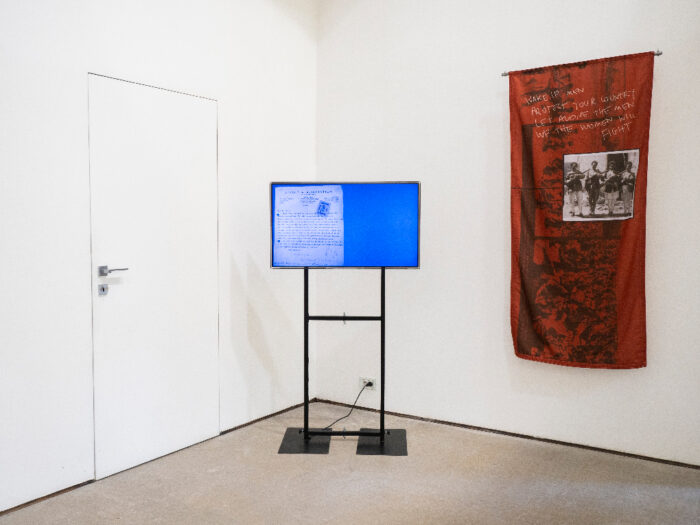
Alessandra Ferrini’s installation My Heritage? integrates the narratives of the exhibition with a site-specific intervention that was conceived for the vestibule of the former Casa d’Italia in Marseille, inaugurated in 1935 and now home to the Italian Cultural Institute. The installation focuses on the historical and ideological context that the building embodies: the intensification of fascist imperial aspirations that culminated in the fascistization of the Italian diaspora and the establishment of the Empire in 1936, following the occupation of Ethiopia. Because the League of Nations did not intervene in a war involving two of its members, the so-called Abyssinian Crisis gave rise to a series of conflicts that eventually led to World War II-a “cascading effect.” On the other hand, the attack on the “last citadel of the black man” (Ras Makonnen), coupled with the brutality of the Italian war, provoked widespread protests and support for the Ethiopian resistance, especially from the Pan-African movements.

Like the other two exhibitions of the trilogy, KAS will have a “static” duration of two months and will be activated with a cycle of performances on the occasion of Live Works Summit 2022. The performance The Song of the Beggar: Villion’s Good Night, The Vain Dreamer by Simon Asencio pays homage to anonymous cant songs compiled in John S. Farmer’s anthology Musa Pedestris. Farmer’s title borrows its name from the wandering muse, whose poetry is that of prose and of the common language, suggesting that slang, cant and vernacular phraseologies are the roots of the poetry form. Using breath, movement and speech, the performance activates a series of ceramic wind instruments, as a rehearsal for a song to come. Giulia Damiani is a writer, researcher, curator and dramaturg based in London and Amsterdam. In her lecture-performance Cerca, tramuta, traduci. Pronuncia corpo e roccia. Le Nemesiache a Napoli Giulia Damiani connects with the artistic and political work of the feminist group Le Nemesiache. She traces lines that are connections between moments, fragments of volcanic geographies that become destabilizing paths for the affirmation of subjectivities and explosive landscapes. They are lines and phrases that break, accumulate and interrupt to begin again in an unexpected dimension through language and movement. This project of exhibition and narration aloud proposes the psycho-fable (a method of self-awareness of the Nemesis that starts from the body) as a slow learning process with the group, intimate and transformative, wishing to put it into circulation and make it vibrate beyond. Labyrinth riders in disremembering Atlantis by Vanja Smiljanic puts us on the traces of Atlantis: in 9600 BCE Atlantis was destroyed. Only a few survived. Following three former Atlantean inhabitants that have lingered in between dimensions ever since, Smiljanic’s performance shows their integration process into the Now.


